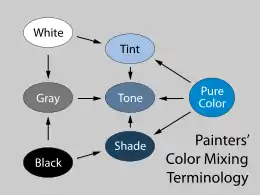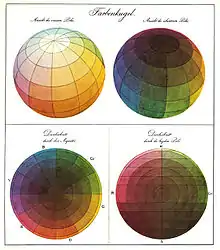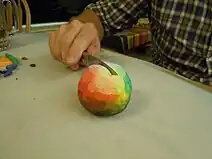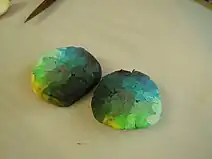A color solid is the three-dimensional representation of a color space or model and can be thought as an analog of, for example, the one-dimensional color wheel, which depicts the variable of hue (red, yellow, green, blue, magenta, etc.); or the two-dimensional chromaticity diagram, which depicts the variables of hue and colorfulness (either chroma or saturation). The added spatial dimension allows a color solid to depict the three dimensions of color: lightness (gradations of light and dark, tints or shades), hue, and colorfulness, allowing the solid to depict all conceivable colors in an organized three-dimensional structure.
Organization
- Vertical cross sections of various spherically-shaped color solids
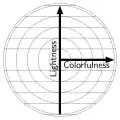 Philipp Otto Runge's Farbenkugel
Philipp Otto Runge's Farbenkugel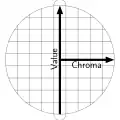 Albert Henry Munsell's color sphere
Albert Henry Munsell's color sphere Johannes Itten's color sphere
Johannes Itten's color sphere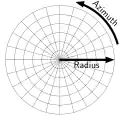 Spherical coordinate system (for comparison)
Spherical coordinate system (for comparison)
Different color theorists have each designed unique color solids. Many are in the shape of a sphere, whereas others are warped three-dimensional ellipsoid figures—these variations being designed to express some aspect of the relationship of the colors more clearly. The color spheres conceived by Phillip Otto Runge and Johannes Itten are typical examples and prototypes for many other color solid schematics.[2]
Pure, saturated hues of equal brightness are located around the equator at the periphery of the color sphere. As in the color wheel, contrasting (or complementary) hues are located opposite each other. Moving toward the center of the color sphere on the equatorial plane, colors become less and less saturated, until all colors meet at the central axis as a neutral gray. Moving vertically in the color sphere, colors become lighter (toward the top) and darker (toward the bottom). At the upper pole, all hues meet in white; at the bottom pole, all hues meet in black.
The vertical axis of the color sphere, then, is gray all along its length, varying from black at the bottom to white at the top. All pure (saturated) hues are located on the surface of the sphere, varying from light to dark down the color sphere. All impure (unsaturated hues, created by mixing contrasting colors) comprise the sphere's interior, likewise varying in brightness from top to bottom.
Usage
Artists and art critics find the color solid to be a useful means of organizing the three variables of color—hue, lightness (or value), and saturation (or chroma), as modelled in the HCL and HSL color models—in a single schematic, using it as an aid in the composition and analysis of visual art.
Color volume
Color volume is the set of all available color at all available hue, saturation and brightness.[3][4] It's the result of a 2D color space or 2D color gamut (that represent chromaticity) combined with the dynamic range.[5][6][7]
The term has been used to describe HDR's higher color volume than SDR (i.e. peak brightness of at least 1,000 cd/m2 higher than SDR's 100 cd/m2 limit and wider color gamut than Rec. 709 / sRGB).[3][5][8][9][10]
See also
References
- ↑ Levkowitz and Herman (1993)
- ↑ Johannes Itten, "The Art of Color", 1961. Trans. Ernst Van Haagen. New York: Reinhold Publishing Corporation, 1966. ISBN 0-442-24038-4.
- 1 2 "HPA Tech Retreat 2014 – Day 4". February 20, 2014. Archived from the original on November 1, 2014. Retrieved April 25, 2021.
- ↑ "Color Volume of TVs: DCI-P3 and Rec. 2020". RTINGS.com. Retrieved April 25, 2021.
- 1 2 "Color Volume: What It Is and Why It Matters for TV". news.samsung.com. Retrieved January 31, 2021.
- ↑ "Color volume of a TV: You should know this about the successor to color space". Homecinema Magazine. July 18, 2020. Retrieved April 25, 2021.
- ↑ "Color Volume: Measuring and Understanding What it Means – ReferenceHT". April 11, 2017. Retrieved April 25, 2021.
- ↑ "BT.2100 : Image parameter values for high dynamic range television for use in production and international programme exchange". www.itu.int. Retrieved April 25, 2021.
- ↑ "BT.1886 : Reference electro-optical transfer function for flat panel displays used in HDTV studio production". www.itu.int. Retrieved April 25, 2021.
- ↑ "BT.2020 : Parameter values for ultra-high definition television systems for production and international programme exchange". www.itu.int. Retrieved April 25, 2021.
External links
- Runge's Color Sphere (Java applet does not work in all Web browsers)
